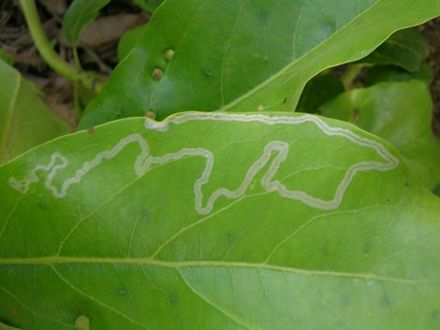Leaf miners are not something you want on your plant, they feed on cannabis leaves. Leaf miners are unsightly and if you don’t treat and leave your plant unattended, it will create serious damage and reduce yields. To keep your lawn safe, proper steps should be taken to reduce leaf miner invasion so that your trees bloom throughout the year! But first, we have to know how to identify leaf miners so that we can find ways to kill them.

Leaf Miner Damage
So What Are Leaf Miners?
To put it in the easiest words it can be said that the larvae of insects (such as sawflies, moths, flies) are called leaf miners. The larvae spend the whole winter in soil and emerge out as young adults in the spring. The female larvae lay up to 250 eggs; they do this by piercing the surface of the leaves with their ovipositor and then depositing their eggs inside the leaves.
It takes around 10 days for the eggs to hatch the resulting larvae then tunnel inside the leaves creating the wavy lines. It takes 2 to 3 weeks for the larvae to get mature; during this time period they live and eat inside the leaf. Note that the tunnel widens as the larvae grow on the leaf.
When these larvae are matured they drop on the ground, dig into the soil of about 1 to 2 inches and pupate. They come out as adults after 15 days, and the cycle begins all over again. In this way, multiple generations of leaf miners can take place during the growing season.
What Are The Favorite Plants of Leaf Miner?
Leaf miners are usually fond of broadleaf plants such as Columbine, blackberries and citrus trees. The vegetable garden is in their menu as well, where they like to feast on cabbage, beans, lettuce, peppers and tomatoes. You can realize now why farmers and gardeners always complain about these bad boys, leaf miners!
What Makes It So Hard to Kill Them?
Leaf miners live inside the leaves. So if you are spraying something it will only coat the outer side of the leaf, doing nothing to kill the actual culprit. On the other hand, if you spray systemic insecticides, it will get inside the leaf and kill leaf miners. BUT, these sprays contain harmful toxic substances that are either banned or not allowed to use on an edible plant in some countries.
But We Have Better Plans
We are going to kill these miners not by using any chemical solution but by using simple organic solutions and keep our garden free of pests.
1. Squish the larvae, make them scream!
Be an attentive watcher; keep a close eye on your leaves. As soon as you notice the characteristic wavy lines, squeeze the leaves. These will kill the larvae immediately (Spot Dead as they say).
2. Dispose them!
You can also break off the leaves which you see has the lines on it. Make sure you dispose these leaves to your proper garbage.
Check any plant that you might be buying from the nursery for pests. Be careful when you are planting any new trees in your garden, if there is any minor evidence of leaf miner activity, remove it from your garden and return it for a refund.
3. Tempt them to go away!
Buy few trap crops and place it in your garden. Trap crops are plants that are quite favorite to pests and leaf miners. The plan here is to lure the pests to infest the trap crops leaving your other valuable plants. Some of the examples of trap crops are columbine, velvetleaf and lambsquarter.
4. Have some barriers to entry!
Keep leaf miners away from your garden by creating more barriers to entry. What you can do use a black plastic and cover the soil in crop rows. These will prevent the mature larvae to all on the soil so they can’t pupate further, and the larvae that are already on the soil are trapped out and can’t emerge out in spring, thus disrupting the life cycle of pests and leaf miners.
5. Find the enemy’s enemy!
So to combat the bad, we need good. To kill the leaf miners, we need parasitic wasps. Just purchase few leaf miner parasites and leave them in your garden. The adults will get into the tunnels, which the leaf miners have created in leaves, and terminate them. Then these parasites will lay a single egg in that tunnel which would hatch into pupae. The pupae live and feed on the dead leaf miner larvae, and then develop into an adult wasp.
So these are a few ways that you can implement to reduce the invasion of leaf miners. Yes, they are difficult to kill as they live inside the leaf, but now, we sure know better ways to lure them away from our precious garden.
Guest Post Submitted by Morgan Antoinette
